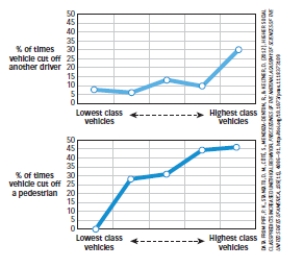Use the following to answer questions
Scenario I
Scenario I is based on and presents data from the following study (reproduced from p.25 of the textbook) :
Piff,P.K. ,Stancato,D.M. ,Côté,S. ,Mendoza-Denton,R. ,& Keltner,D.(2012) .Higher social class predicts increased unethical behavior.PNAS Proceedings of the National Academy of Sciences of the United States of America,109(11) ,4086-4091.doi:10.1073/pnas.1118373109
Piff and colleagues (2012) used naturalistic observation techniques to determine if wealthy people behaved more or less ethically than people who were not wealthy.In one study,observers stood at a busy intersection and recorded the make,model,and year of each approaching car.They also noted if the car cut off other cars or pedestrians at this intersection.
Major findings of Piff et al.(2012) are presented in Figure 1.1.This figure shows the percentage of times vehicles cut off another driver (top panel) or pedestrians (lower panel) as a function of the social status of the vehicles (with more expensive cars ranked higher in social status) .
Figure 1.1 
-(Scenario I) Consider only the bottom panel in Figure 1.1.These results demonstrate that:
Definitions:
Q40: Research by Perani and coworkers on how
Q107: (Scenario I)Using Binet and Simon's original intelligence
Q108: Leichtman and Ceci investigated how misleading information
Q149: The Stanford-Binet intelligence test was modified most
Q191: According to psychologist Alan Baddeley,working memory is
Q226: When asked to reproduce or draw a
Q241: Gestalt psychologists believed that the mind imposes
Q292: Identical twins are also called dizygotic twins.
Q364: A cognitive psychologist who argued that it
Q447: In his classic studies on memory,Hermann Ebbinghaus